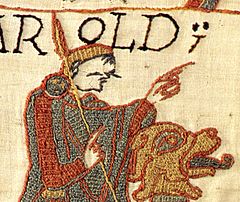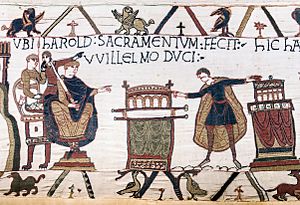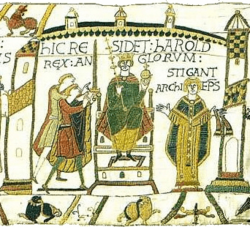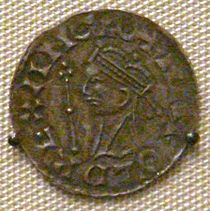Harold Godwinson facts for kids
Quick facts for kids Harold Godwinson |
|
|---|---|

Harold Godwinson, from the Bayeux Tapestry
|
|
| King of the English | |
| Reign | 5 January – 14 October 1066 |
| Coronation | 6 January 1066 |
| Predecessor | Edward the Confessor |
| Successor |
|
| Born | c. 1022 Wessex, England |
| Died | 14 October 1066 (aged about 44) near Senlac Hill, Sussex, England |
| Burial | Waltham Abbey, Essex, or Bosham, Sussex (disputed) |
| Spouse | |
| Issue | |
| House | Godwin |
| Father | Godwin, Earl of Wessex |
| Mother | Gytha Thorkelsdóttir |
Harold Godwinson (born around 1022 – died 14 October 1066), also known as Harold II, was the very last Anglo-Saxon king of England. He ruled for a short time, from January 6, 1066, until his death on October 14, 1066. Harold died fighting against the Norman invaders led by William the Conqueror at the famous Battle of Hastings. His death marked the end of Anglo-Saxon rule in England.
Harold Godwinson came from a very important Anglo-Saxon family. His family had connections to King Cnut the Great. After his father, Godwin, Earl of Wessex, passed away, Harold became a powerful earl himself. When his brother-in-law, King Edward the Confessor, died without a child to take his place in January 1066, the English council (called the Witenagemot) chose Harold to be the next king. He was likely the first English king to be crowned in Westminster Abbey.
In September 1066, Harold successfully stopped an invasion from Norway, led by Harald Hardrada, near York. Just two weeks later, he marched his army quickly back south to face William the Conqueror at Hastings.
Contents
Harold's Family and Early Life
Harold was the son of Godwin, who was a very powerful earl (a high-ranking nobleman) in Wessex. His mother was Gytha Thorkelsdóttir. Harold's family was well-connected; his mother's brother was married to the sister of Cnut the Great, a famous king of England and Denmark.
Godwin, Harold's father, became an earl in 1018. He grew very powerful during Cnut's reign. After Cnut died, Godwin helped to choose the next kings. In 1045, Godwin's power reached its peak when his daughter, Edith, married King Edward the Confessor.
Harold had several brothers and sisters. His brothers were Sweyn, Tostig, Gyrth, Leofwine, and Wulfnoth. His sisters included Edith, who married King Edward. Harold was likely born around 1020.
Becoming a Powerful Leader
Around 1045, Harold became the Earl of East Anglia. This was an important position, possibly to help defend England from threats from Norway. Harold's older brother, Sweyn, had also become an earl earlier.
In 1051, King Edward the Confessor had a disagreement with the Godwins and sent them away from England. But the Godwins gathered an army and forced the king to let them return a year later. When Harold's father, Earl Godwin, died in 1053, Harold took his place as the Earl of Wessex. This made Harold the most powerful nobleman in England, second only to the king.
Harold was also a skilled military leader. He fought against the Welsh, who had attacked English lands. He led successful campaigns against Gruffydd ap Llywelyn, the king of Wales, from 1062 to 1063. This conflict ended with Gruffydd's defeat and death.
Harold's Journey to France

In 1064, Harold was shipwrecked in Ponthieu, a region in northern France. Historians have different ideas about why Harold was on this journey. Some say King Edward had sent him to promise the English throne to Duke William II of Normandy. However, the English did not usually choose their kings this way; a council of important leaders (the Witenagemot) made the decision.
Other stories suggest Harold was trying to get family members released who were being held hostage. Or perhaps he was just on a hunting trip and a storm blew his ship off course. He landed in Ponthieu and was captured by Count Guy I. William of Normandy soon arrived and demanded that Guy hand Harold over.
Harold then joined William in a battle against William's enemy, Conan II. During this time, Harold is shown in the Bayeux Tapestry rescuing two of William's soldiers from quicksand. After the battle, William gave Harold weapons and made him a knight. The Tapestry and other Norman records show that Harold swore an oath to William, promising to support his claim to the English throne. After King Edward died, the Normans used this oath to say Harold had broken his word when he became king.
In 1065, Harold supported rebels in Northumbria against his own brother, Tostig. This was because Tostig had raised taxes too much, threatening to cause a civil war. This decision helped Harold gain support in the north but also caused a serious split in his family, leading Tostig to join forces with King Harald Hardrada of Norway.
Harold Becomes King

At the end of 1065, King Edward the Confessor became very ill and died on January 5, 1066. He had not clearly named who should take his place. The next day, the Witenagemot (the council of English leaders) chose Harold to be the new king. His coronation probably happened on January 6 at Westminster Abbey. Norman sources later said this coronation happened too quickly, but it might have been because many important nobles were already in Westminster for a religious festival.
When William of Normandy heard that Harold had been crowned, he immediately began planning to invade England. He built a large fleet of ships. At first, William struggled to get support, but after claiming Harold had broken his oath, the Pope officially supported William's claim to the English throne. Many nobles then joined William's cause.
Harold gathered his own troops on the Isle of Wight to prepare for William's invasion. However, William's fleet stayed in port for nearly seven months, perhaps due to bad winds. On September 8, Harold had to send his army home because they were running out of supplies. On that same day, King Harald Hardrada of Norway, along with Harold's brother Tostig, landed their invasion force in northern England.
Hardrada and Tostig's forces defeated the English earls Edwin and Morcar near York on September 20, 1066. Harold quickly marched his army north from London, covering the distance in just four days. He surprised Hardrada and Tostig. On September 25, at the Battle of Stamford Bridge, Harold defeated both Hardrada and Tostig.
The Battle of Hastings

HIC CECIDERUNT LEVVINE ET GYRÐ FRATRES HAROLDI REGIS
(Here have fallen dead Leofwine and Gyrth, brothers of King Harold)
On September 27, 1066, William's Norman fleet finally sailed for England. They landed the next day at Pevensey in Sussex. Harold's army marched about 240 miles (386 km) south to meet William, who had landed around 7,000 men. Harold set up his army on a hill near Hastings.
The two armies fought at the Battle of Hastings, on Senlac Hill (near the modern town of Battle), on October 14. After nine hours of very hard fighting, Harold was killed, and his forces were defeated. His brothers, Gyrth and Leofwine, also died in the battle.
Burial and What Happened Next
After the battle, the Norman writer William of Poitiers said that Harold's body was given to William Malet for burial. Harold's mother offered a large amount of gold for his body, but William refused. Some accounts say Harold's wife, Edith the Fair, had to identify his body by a special mark.
Because Harold had strong ties to Bosham, his birthplace, and an Anglo-Saxon coffin was found there in 1954, some people believe he might be buried in Bosham Church. However, a request to dig up a grave there was denied in 2003 because it was unlikely they could prove it was Harold.
There are also stories that Harold's body was later given a proper funeral at Waltham Abbey Church in Essex, a church he had supported. Some legends even claimed that Harold didn't die at Hastings but escaped and lived out his life as a hermit.
Harold's son, Ulf, was later released from prison by King William. Two of Harold's other sons, Godwine and Edmund, tried to invade England in 1068 and 1069 with help from an Irish king, but they were defeated.
Harold's Family and Children
Harold was with Edith the Fair for about twenty years, and they had at least five children together.
Around January 1066, Harold married Ealdgyth, who was the daughter of Earl Ælfgar and the widow of the Welsh prince Gruffydd ap Llywelyn. After Harold died at the Battle of Hastings, Ealdgyth, who was pregnant, was taken to Chester by her brothers for safety. What happened to her after that is not fully known.
Some historians believe Harold and Ealdgyth had no children together, while others say they had two sons, Harold and Ulf. It's possible these boys were twins born after their father's death. Another idea is that Ulf was the son of Edith the Fair.
There is a story that Edith the Fair took Harold's body to Waltham Holy Cross to be buried. The fate of Harold's sons after their defeat in 1069 is also unclear, though some sources suggest they found safety with their grandmother, aunt, and sister in Denmark.
| Family of Harold Godwinson | ||||||||||||||||||||||||||||||||||||||||||||||||||||||||||||||||||||||||||||||||||||||||||||||||||||||||||||||||||||||||||||||||||||||||||||||||||||||||||||||||||||||||||||||||||||||||||||||||||||||||||||||||||||||||||||||||||||||||||||||||||||||||||||||||||||||||||||||||||||||||||||||||||||||||||||||||||||||||||||||||||||||||||||||||||||||||||||||||||||||||||||||||||||||||||||||||||||||||||||||||||||||||||||||||||||||||||||||||||||||||||||||||||||||||||||||||||||||||||||||||||||||||||||||||||||||||||||||||||||||||||||||
|---|---|---|---|---|---|---|---|---|---|---|---|---|---|---|---|---|---|---|---|---|---|---|---|---|---|---|---|---|---|---|---|---|---|---|---|---|---|---|---|---|---|---|---|---|---|---|---|---|---|---|---|---|---|---|---|---|---|---|---|---|---|---|---|---|---|---|---|---|---|---|---|---|---|---|---|---|---|---|---|---|---|---|---|---|---|---|---|---|---|---|---|---|---|---|---|---|---|---|---|---|---|---|---|---|---|---|---|---|---|---|---|---|---|---|---|---|---|---|---|---|---|---|---|---|---|---|---|---|---|---|---|---|---|---|---|---|---|---|---|---|---|---|---|---|---|---|---|---|---|---|---|---|---|---|---|---|---|---|---|---|---|---|---|---|---|---|---|---|---|---|---|---|---|---|---|---|---|---|---|---|---|---|---|---|---|---|---|---|---|---|---|---|---|---|---|---|---|---|---|---|---|---|---|---|---|---|---|---|---|---|---|---|---|---|---|---|---|---|---|---|---|---|---|---|---|---|---|---|---|---|---|---|---|---|---|---|---|---|---|---|---|---|---|---|---|---|---|---|---|---|---|---|---|---|---|---|---|---|---|---|---|---|---|---|---|---|---|---|---|---|---|---|---|---|---|---|---|---|---|---|---|---|---|---|---|---|---|---|---|---|---|---|---|---|---|---|---|---|---|---|---|---|---|---|---|---|---|---|---|---|---|---|---|---|---|---|---|---|---|---|---|---|---|---|---|---|---|---|---|---|---|---|---|---|---|---|---|---|---|---|---|---|---|---|---|---|---|---|---|---|---|---|---|---|---|---|---|---|---|---|---|---|---|---|---|---|---|---|---|---|---|---|---|---|---|---|---|---|---|---|---|---|---|---|---|---|---|---|---|---|---|---|---|---|---|---|---|---|---|---|---|---|---|---|---|---|---|---|---|---|---|---|---|---|---|---|---|---|---|---|---|---|---|---|---|---|---|---|---|---|---|---|---|---|---|---|---|---|---|---|---|---|---|---|---|---|---|---|---|---|---|---|---|---|---|---|---|---|---|---|---|---|---|---|---|---|---|---|---|---|---|---|---|---|---|---|---|---|---|---|---|---|---|---|---|---|---|---|---|---|---|---|---|---|---|---|---|---|---|---|---|---|---|---|---|---|---|---|---|---|---|---|---|---|---|---|---|---|---|---|---|---|---|---|---|---|
|
||||||||||||||||||||||||||||||||||||||||||||||||||||||||||||||||||||||||||||||||||||||||||||||||||||||||||||||||||||||||||||||||||||||||||||||||||||||||||||||||||||||||||||||||||||||||||||||||||||||||||||||||||||||||||||||||||||||||||||||||||||||||||||||||||||||||||||||||||||||||||||||||||||||||||||||||||||||||||||||||||||||||||||||||||||||||||||||||||||||||||||||||||||||||||||||||||||||||||||||||||||||||||||||||||||||||||||||||||||||||||||||||||||||||||||||||||||||||||||||||||||||||||||||||||||||||||||||||||||||||||||||
See also
 In Spanish: Haroldo II de Inglaterra para niños
In Spanish: Haroldo II de Inglaterra para niños



